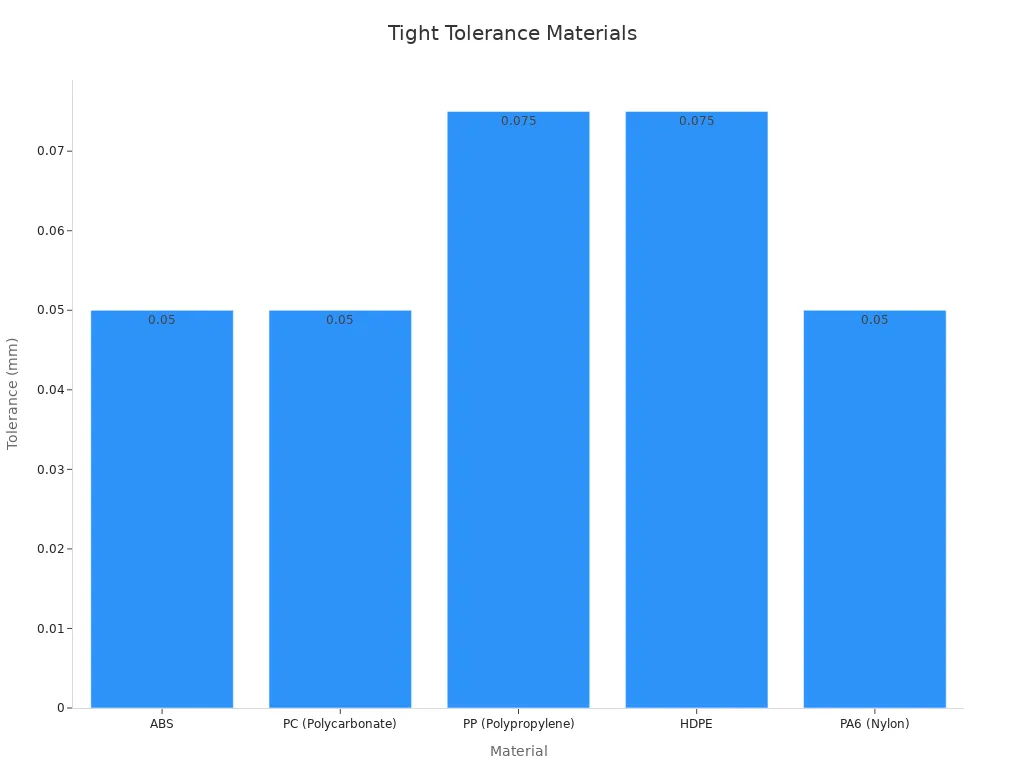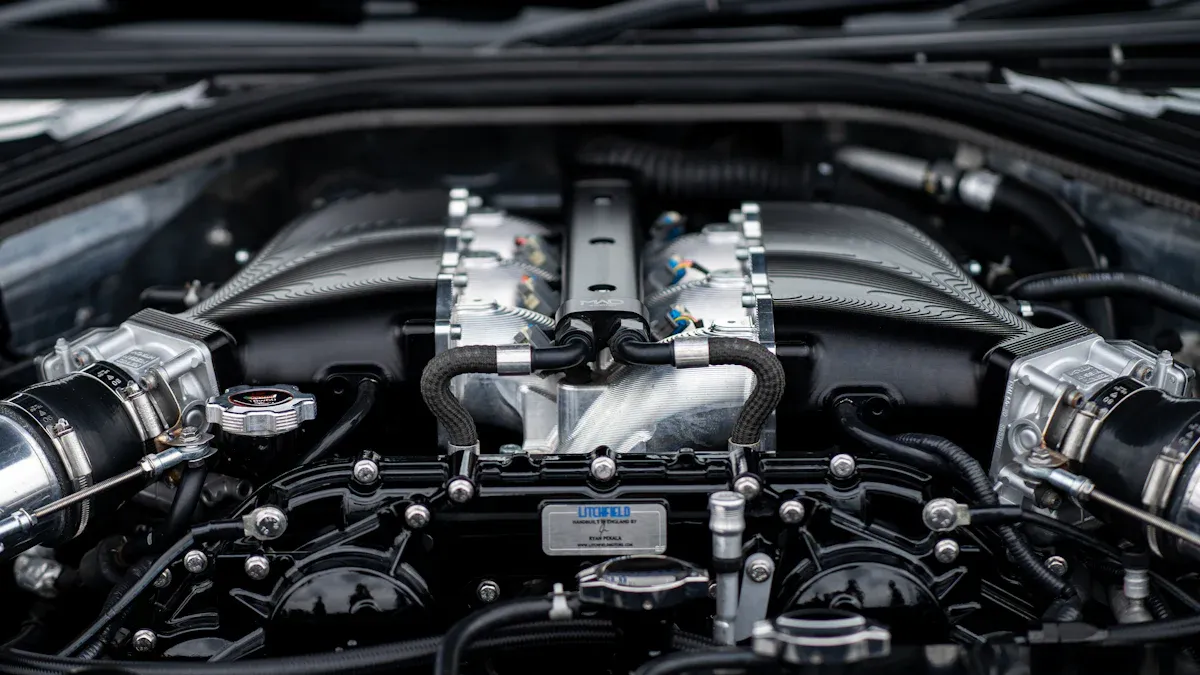
In automotive design, tight tolerance molding plays a pivotal role by achieving an impressive accuracy of ±0.005mm. This level of precision ensures that every part fits together seamlessly, enabling vehicles to perform at their best. You rely on this technology for lightweight and durable components that improve fuel efficiency and reduce emissions. Even a minor deviation in tight tolerance can lead to failures, increased costs, or safety risks. By prioritizing precision, manufacturers create safer and more reliable vehicles for the road.
Tight tolerance molding refers to the process of manufacturing parts with extremely precise dimensions. This process ensures that components fit together perfectly, even when the margin for error is as small as ±0.005mm. You often see this level of precision in industries like automotive, aerospace, and medical, where accuracy is critical.
In automotive design, tight tolerance molding plays a key role in creating parts that meet strict specifications. For example, materials like polypropylene and polycarbonate are commonly used. Polypropylene works well for bumpers because it resists moisture and sunlight. Polycarbonate, on the other hand, is ideal for headlights due to its high light transmission and temperature stability. These materials, combined with tight tolerances, ensure durability and performance in demanding environments.
Achieving ±0.005mm accuracy is essential for producing high-quality automotive parts. This level of precision ensures that components align correctly, reducing the risk of mechanical failure. For instance, high-precision CNC machining centers can achieve this accuracy, minimizing dimensional errors in critical applications. These machines often include online measurement systems to monitor and maintain accuracy during production.
When you work with tight tolerances, you also improve consistency across production runs. Metrics like Pp and Cp help assess whether the process can produce parts centered at the desired dimensions. A Pp value of 1.33 or higher indicates a capable process. Similarly, Ppk and Cpk metrics evaluate current performance, with a Ppk value of 1.33 or more showing that the process meets specifications. These benchmarks highlight the importance of maintaining tight tolerances to ensure reliability and safety in automotive systems.
Manufacturers use several methods for achieving tight tolerances in automotive parts. One common approach is tight tolerance machining, which involves advanced CNC machining techniques. These machines can produce components with intricate geometries and tight machining tolerances, making them ideal for high-performance applications.
To achieve consistent results, you need to carefully select materials that respond well to machining processes. For example, materials like polypropylene and polycarbonate maintain their properties across a wide temperature range, making them suitable for tight tolerance molding. Additionally, working in a controlled environment helps minimize temperature fluctuations, which can affect part dimensions.
Another important factor is tooling design. High-precision cutting tools and well-maintained equipment are essential for reducing deviations. Manufacturers also rely on Coordinate Measuring Machines (CMMs) to verify dimensions with an accuracy of up to ±0.001mm. These tools ensure that parts meet specifications and maintain quality throughout production.
By combining these methods, you can achieve the precision required for modern automotive design. Tight tolerances not only enhance performance but also drive innovation in the industry.
Choosing the right material is one of the most critical challenges in tight tolerance molding. Each material behaves differently during the molding process, affecting its ability to meet tight tolerances. For example, materials with low shrinkage rates, such as ABS and polycarbonate, perform exceptionally well in maintaining dimensional accuracy.
| Material | Shrinkage Rate (%) | Tolerance Performance |
|---|---|---|
| ABS | 0.4 – 0.8% | Excellent |
| Polycarbonate (PC) | 0.5 – 0.7% | Excellent |
| Polyamide (PA) | 0.7 – 1.4% | Good |
| Polypropylene (PP) | 1.0 – 2.5% | Moderate |
| HDPE | 1.5 – 3.0% | Moderate |
When selecting materials, you must also consider their tolerance capabilities. For instance, ABS and polycarbonate can achieve very tight tolerances of ±0.025mm, making them ideal for precision automotive parts.

Tooling design plays a pivotal role in achieving tight tolerances. High-precision tools ensure consistent part quality, reduce defects, and minimize production downtime. For example, manufacturers in the automotive industry often integrate CAD models with Coordinate Measuring Machines (CMMs) to detect variances immediately. This approach enhances precision and reduces errors in critical components like engine parts.
Tip: Investing in durable, high-quality tools not only improves accuracy but also reduces maintenance costs and production delays.
Advanced tooling also supports tight tolerance machining by maintaining tight machining tolerances throughout the production cycle. This consistency is essential for meeting the stringent requirements of modern automotive systems.
Maintaining tight tolerances requires meticulous process control. Scientific injection molding techniques, for instance, emphasize precise control over variables like temperature, pressure, and flow rate. Real-time monitoring of these parameters helps detect deviations early, ensuring consistent results.
Statistical process control (SPC) is another effective method. By analyzing production data, you can identify trends and make data-driven adjustments to keep the process within desired tolerance limits. This approach is particularly useful in large production runs, where even minor deviations can lead to significant failures.
Note: Effective process control not only ensures reliability but also reduces costly rework and waste, making it a cornerstone of tight tolerance molding.

Tight tolerance molding significantly improves the performance and reliability of automotive components. When parts are manufactured with tight tolerances, they fit together seamlessly, reducing wear and tear over time. This ensures that your vehicle operates smoothly, even under demanding conditions.
High precision processes, such as CNC machining, play a vital role in achieving this level of accuracy. These processes allow manufacturers to produce intricate components with tolerances as close as ±0.0002 inches. This precision is especially critical for automotive electronics, where even the smallest deviation can lead to malfunctions.
| Benefit | Description |
|---|---|
| High Precision | Achieves tolerances as tight as +/-0.01 to +/-0.02 inches, crucial for automotive electronics. |
| Consistency and Reliability | Automated systems ensure minimal variation and adherence to strict automotive standards. |
| Cost Efficiency | Reduces production costs while maintaining high-quality standards for complex automotive components. |
By maintaining stringent tolerances, you also benefit from consistent quality across large production runs. This consistency ensures that every vehicle meets the same high standards, enhancing overall reliability.
Tight tolerance molding directly impacts the safety of automotive systems. When components are manufactured with high precision, they perform as intended, reducing the risk of mechanical failures. For example, a manufacturer once faced assembly issues due to brackets being off by just 0.5 mm. This small deviation caused delays and additional costs. After implementing stricter tolerance checks, the company resolved these issues and improved product quality.
By prioritizing tight tolerances, you can ensure that safety-critical components, such as airbags and braking systems, function reliably. This not only protects passengers but also builds trust in your brand.
Tight tolerance molding drives innovation by enabling the production of complex and advanced automotive systems. For instance, intricate die castings, such as the Al Die Cast Propane Vaporizer, demonstrate how tight tolerances can meet stringent specifications. These award-winning designs highlight the role of precision in pushing the boundaries of automotive technology.
| Case Study | Description |
|---|---|
| Intricate Al Die Cast Propane Vaporizer | Highlights the importance of tight tolerances in automotive applications, with award-winning die castings that meet stringent specifications. |
| Mg IMA Process Technology Award | Details on a new Mg die cast structure for automotive mirrors, highlighting the elimination of trimming operations and the use of advanced molding techniques. |
Advanced molding techniques also allow for customization, ensuring that components meet specific industry demands. This flexibility supports the development of innovative systems, such as lightweight materials for improved fuel efficiency or advanced sensors for autonomous vehicles. By leveraging tight tolerance machining, you can stay ahead in a competitive market and deliver cutting-edge solutions.

Engine components rely heavily on tight tolerances to ensure optimal performance and durability. Proper dimensions are critical for parts like pistons, cylinder heads, and fuel injectors. Even a minor deviation can lead to inefficiencies or mechanical failures. For instance, typical injection molding tolerances range from ±0.1mm, but achieving very tight tolerances of ±0.025mm ensures precise fits and reduces friction. This precision prolongs the lifespan of engine parts and enhances reliability.
High precision plastic parts also play a vital role in automotive electronics within the engine. Connectors, circuit boards, and sensor housings require specific geometries to function correctly. Materials like polyamide and liquid crystal polymers maintain their properties in extreme conditions, emphasizing the importance of tight tolerance molding.
Transmission systems demand exceptional precision to function smoothly. Tight tolerance machining ensures that gears, shafts, and housings align perfectly, reducing wear and improving efficiency. Statistical evaluations show that manufacturing tolerances often meet capability values above 1.67, resulting in a reject rate of only 0.57 parts per million. This high level of precision minimizes production waste and ensures consistent quality.
When calculating machining tolerances for transmission components, manufacturers must account for the challenges of maintaining tight tolerances. Only about 50% of the intended drawing tolerances are available as manufacturing tolerances. Despite these challenges, tight tolerance molding enables the production of reliable and durable transmission systems.
Safety-critical parts, such as airbags, braking systems, and seatbelt mechanisms, depend on tight tolerances to perform reliably. These components must meet stringent safety standards to protect passengers. For example, automotive lighting systems require precise plastic parts for lenses and reflectors. These parts must provide UV protection and remain stable under temperature variations.
Climate control and HVAC systems also rely on high precision plastic parts, such as blower housings and air ducts. These components must withstand constant temperature changes without deforming. By using tight tolerance molding, you can ensure that safety-critical parts meet the highest standards of performance and reliability.
Tight tolerance molding forms the backbone of modern automotive manufacturing. It enables you to produce parts with unmatched precision, ensuring seamless performance and safety. Industry trends highlight the growing demand for high-precision components, pushing manufacturers to invest in advanced equipment and materials. As Ken Eberle notes, sophisticated engineering and tooling are essential to meet these specifications. Maintaining ±0.005mm accuracy prevents issues like reduced engine life or increased oil consumption. By embracing this technology, you can reduce warranty claims, extend component life, and improve customer satisfaction, ensuring your designs meet evolving industry demands.
Tight tolerance molding creates precise parts for critical automotive systems. You see it in engine components, transmission systems, and safety-critical parts. This precision ensures seamless performance, reduces wear, and enhances reliability.
It ensures components like airbags and braking systems meet strict standards. Precise dimensions prevent malfunctions, protecting passengers and boosting trust in your brand.
Materials like ABS and polycarbonate perform well due to their low shrinkage rates. These materials maintain dimensional accuracy, making them ideal for automotive applications.
Yes, it minimizes defects and waste. By maintaining consistent quality, you avoid costly rework and delays, improving overall efficiency.
Coordinate Measuring Machines (CMMs) and high-precision CNC machines ensure accuracy. These tools verify dimensions and maintain quality throughout production.